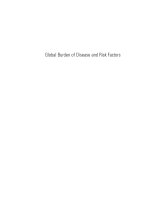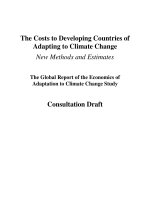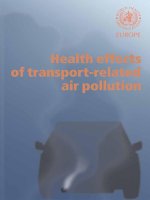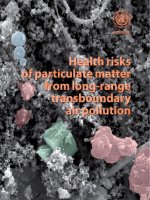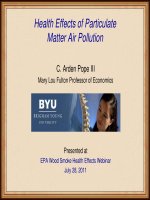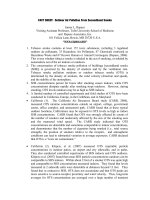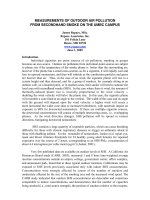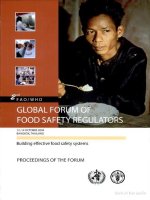THE GLOBAL BURDEN OF DISEASE DUE TO OUTDOOR AIR POLLUTION ppt
Bạn đang xem bản rút gọn của tài liệu. Xem và tải ngay bản đầy đủ của tài liệu tại đây (244.07 KB, 7 trang )
1
Journal of Toxicology and Environmental Health, Part A, 68:1–7, 2005
Copyright© Taylor & Francis Inc.
ISSN: 1528–7394 print / 1087–2620 online
DOI: 10.1080/15287390590936166
THE GLOBAL BURDEN OF DISEASE DUE TO OUTDOOR AIR
POLLUTION
Aaron J. Cohen,
1
H. Ross Anderson,
2
Bart Ostra, Kiran Dev Pandey,
Michal Krzyzanowski, Nino Künzli, Kersten Gutschmidt, Arden Pope,
Isabelle Romieu, Jonathan M. Samet, Kirk Smith
1
Health Effects Institute, Boston, Massachusetts, USA,
2
Community Health Sciences, St. George's Hospital Medical School,
University of London, United Kingdom
California Environmental Protection Agency, Oakland, CA USA
Global Environment Facility, Washington, DC USA
WHO European Center for Environment and Health Bonn, Germany
Keck School of Medicine, University of Southern California, Los Angeles,
CA USA
WHO International Programme for Protection of the Human Environment,
Geneva, Switzerland
Brigham Young University, Provo, UT USA
Instituto Nacional de Salud Publica, Cuenavaca, Mexico
Johns Hopkins Bloomberg School of Public Health, Baltimore, MD USA
University of California Berkeley, School of Public Health, Berkeley,
CA USA
As part of the World Health Organization (WHO) Global Burden of Disease Comparative Risk
Assessment, the burden of disease attributable to urban ambient air pollution was estimated in
terms of deaths and disability-adjusted life years (DALYs). Air pollution is associated with a
broad spectrum of acute and chronic health effects, the nature of which may vary with the
pollutant constituents. Particulate air pollution is consistently and independently related to the
most serious effects, including lung cancer and other cardiopulmonary mortality. The analyses
on which this report is based estimate that ambient air pollution, in terms of fine particulate air
pollution (PM
2.5
), causes about 3% of mortality from cardiopulmonary disease, about 5% of
mortality from cancer of the trachea, bronchus, and lung, and about 1% of mortality from
acute respiratory infections in children under 5 yr, worldwide. This amounts to about 0.8 mil-
lion (1.2%) premature deaths and 6.4 million (0.5%) years of life lost ( YLL). This burden occurs
predominantly in developing countries; 65% in Asia alone. These estimates consider only the
impact of air pollution on mortality (i.e., years of life lost) and not morbidity (i.e., years lived
with disability), due to limitations in the epidemiologic database. If air pollution multiplies both
incidence and mortality to the same extent (i.e., the same relative risk), then the DALYs for
cardiopulmonary disease increase by 20% worldwide.
The members of the Urban Air Pollution Working Group are: Aaron J. Cohen (cochair), H. Ross Anderson
(cochair), Bart Ostro, Kiran Dev Pandey, Michal Kryzanowski, Nino Kuenxli, Kersten Gutschmidt, Arden
Pope, Isabelle Romieu, Jonathan M. Samet, and Kirk Smith.
The views expressed in this article are those of the authors and do not necessarily reflect the views of
the Health Effects Institute (HEI) or its sponsors.
Address correspondence to Aaron J. Cohen, Principal Scientist, Health Effects Institute, 120 Second
Ave., Charleston Navy Yard, Boston MA 02129-4533, USA. E-mail:
UTEH57026.fm Page 1 Friday, May 20, 2005 9:31 PM
2 A. J. COHEN AND H. R. ANDERSON
In 2000 the World Health Organization (WHO) initiated a comparative
risk assessment (CRA) as part of its ongoing Global Burden of Disease project.
The burden of disease in terms of deaths and disability-adjusted life years
(DALYs) was estimated for 26 major risk factors by age, sex, and disease,
worldwide and for each of 14 world regions. The burden of disease attribut-
able to urban outdoor air pollution was estimated, along with the burdens of
other environmental factors such as indoor air pollution, water quality, lead,
and climate change. The project involved more than 100 researchers from 30
different institutions, and some 200 peer reviewers. The groups charged with
generating estimates for each risk factor agreed on minimal standards of quality
and quantity of evidence, and agreed to use a common approach for estimating
the attributable burden. As a result, the WHO CRA provides results that are
coherent and reasonably comparable across factors. This comparability is fur-
ther enhanced by use of the same international database of mortality and mor-
bidity for the year 2000 (WHO, 2001a, 2001b) based on the Global Burden of
Disease Database (Murray & Lopez, 1996). The summary results of the CRA
were released in the World Health Report (WHO, 2002) and published in The
Lancet (Ezzati et al., 2002); detailed descriptions of the methods and results
how available (Ezzati et al., 2004), including a detailed description of the
methods and results for Urban Outdoor Air Pollution (Cohen et al., 2004).
Current scientific evidence, derived largely from studies in North America
and western Europe, indicates that air pollution from the combustion of fossil
fuels causes a spectrum of health effects from eye irritation to death. Recent
assessments suggest that the public health impacts may be considerable. This
evidence has increasingly been used by national and international agencies to
inform environmental policies, and quantification of the impact of air pollution
on the public health has increasingly became a critical component in the
policy discussion as governments weigh options for pollution control.
Quantifying the magnitude of those impacts in cities worldwide, however,
presents considerable challenges due to limited information on both health
effects and air pollution exposures in many parts of the world. Man-made
outdoor air pollution in the world’s cities, derived largely from combustion
processes, is a complex mixture with many toxic components. We indexed
this mixture in terms of particulate matter (PM), a component that has been
consistently linked with serious health effects and, importantly, that can be
estimated worldwide. Exposure to PM has been associated with a wide range
of health effects, but its effects on mortality are arguably the most important,
and are also most amenable to global assessment. Our estimates, therefore,
consider only mortality. Currently, most epidemiological evidence and air
quality data that could be used for such estimates come from the developed
world. Therefore we have had, therefore, to make assumptions concerning
factors such as the transferability of risk functions, exposure of the population,
and its underlying vulnerability to air pollution, while trying to ensure that
these assumptions are transparent and that the uncertainty associated with
them is assessed through appropriate sensitivity analyses.
UTEH57026.fm Page 2 Friday, May 20, 2005 9:31 PM
GLOBAL BURDEN OF DISEASE 3
METHODS
In order to provide comparable estimates of exposure to outdoor air
pollution for all 14 WHO regions, models developed by the World Bank
were used to estimate concentrations of inhalable particles (PM
10
) (Pandey
et al., 2004). Specifically, economic, meteorologic, and demographic data
and available PM measurements in 304 cities were used to estimate PM
10
levels in all 3211 cities worldwide with populations greater than 100,000 and
capital cities. The estimated distribution of the world’s urban population and
that of the urban population of each of the 14 regions are shown in Figure 1.
To allow the most appropriate epidemiologic studies to be used for burden
estimation, the PM
10
estimates were converted to estimates of fine particles
(PM
2.5
) using available information on geographic variation in the PM
2.5
/
PM
10
ratio. Population-weighted regional annual means for each PM
2.5
and
PM
10
estimate were obtained using the city’s population in the year 2000.
Burden estimates were based on the contributions of three health out-
comes: mortality from cardiopulmonary causes in adults, mortality from lung
cancer, and mortality from acute respiratory infections in children from 0 to 5
yr of age. Attributable numbers of deaths and years of life lost for adults and
children (<5 yr) were estimated using risk coefficients from a large U.S.
cohort study of adults (Pope et al., 2002) and a meta-analysis summary of five
time-series studies of mortality in children, respectively. Base-case estimates
FIGURE 1. Distribution of the urban population according to estimated concentrations of PM
10
in cities
with populations of >100,000 and in national capitals, by subregion. From Cohen et al. (2004).
0%
10%
20%
30%
40%
50%
60%
70%
80%
90%
100%
AMR-A EUR-A EUR-C WPR-A AMR-B AFR-E EMR-B EUR-B AMR-D World AFR-D SEAR-D WPR-B EMR-D SEAR-B
Subregion
Pecent of urban population
>100
60–100
30–60
15–30
<15
UTEH57026.fm Page 3 Friday, May 20, 2005 9:31 PM
4 A. J. COHEN AND H. R. ANDERSON
were calculated with an assumption that the risk of death increases linearly
over a range of annual mean concentrations of PM
2.5
between counterfactual
value (or theoretical minimum) levels of 7.5 and 50 µg/m
3
. The statistical
uncertainty of the base-case estimates was quantified by estimating the joint
uncertainty in the estimates of annual mean concentration and the estimates
of the relative risks. The sensitivity of the base-case estimates to alternative
choices of concentration-response function and counterfactual values was
also assessed (Figure 2).
RESULTS
Outdoor PM air pollution is estimated to be responsible for about 3% of
adult cardiopulmonary disease mortality; about 5% of trachea, bronchus, and
lung cancer mortality; and about 1% of mortality in children from acute respi-
ratory infection in urban areas worldwide. This amounts to about 0.80 million
(1.2%) premature deaths and 6.4 million (0.5%) lost life years (Table 1 and
Figure 3). The worldwide estimates and most regional estimates varied by less
than twofold (50% uncertainty interval). Model uncertainty due to assumptions
about the shape of the concentration-response function, the choice of coun-
terfactual level for PM, and other factors was assessed in sensitivity analyses.
For the most part, the worldwide estimates in each sensitivity case are within
the 50% uncertainty intervals for the base-case estimates. The sensitivity analyses
FIGURE 2. Alternative concentration-response curves for cardiopulmonary deaths. From Cohen et al. (2004).
PM
2.5
(µg/m
3
)
0 5 10 15 20 25 30 35 40 45 50 55 60 65 70 75 80 85 90
RR
1.00
1.25
1.50
Base Case, PM
2.5
Max=50
PM2.5 Max=30
Linear Extrapolation
Log-linear Extrapolation
Counterfactual
level of 7.5 µg/m
3
UTEH57026.fm Page 4 Friday, May 20, 2005 9:31 PM
GLOBAL BURDEN OF DISEASE 5
indicate that base-case estimates were most sensitive to the choice of concen-
tration-response function and theoretical minimum level.
The burden of disease due to urban air pollution occurs predominantly
in developing countries; developing Asia is estimated to contribute approxi-
mately two-thirds of the global burden (Table 1). Moreover, the burden of
air pollution from all sources considered in the CRA (indoor, outdoor, occu-
pational, and lead) accounts for about 1.9 million premature deaths annu-
ally, about 5.4% of the total disease burden in the 3 regions in terms of DALYs
(Health Effects Institute [HEI], 2004). This burden is quite noteworthy: it is, for
example, half again as much as that of tobacco and twice that of unsafe sex
(due to acquired immunodeficiency syndrome and other risks) (WHO, 2002).
DISCUSSION
The results indicate that the impact of outdoor air pollution on the burden
of disease in the world’s cities is large, but an assessment of sources of uncer-
tainty, including the fact that only mortality impacts of exposure to PM were
estimated, suggests that the impact is actually underestimated. Variation in the
TABLE 1. Excess Deaths from Selected Environmental Factors
Environmental risks Global estimate
Asian estimate
(S, SE Asia + W Pacific)
Asia as a
percent of global
Unsafe water 1,730,000 730,000 42%
Urban outdoor air 799,000 487,000 65%
Indoor air 1,619,000 1,025,000 63%
Lead 234,000 88,000 37%
FIGURE 3. Years of life lost attributable to urban air pollution by region.
DALY (YLL) attributable to PM2.5
0
500
1000
1500
2000
2500
3000
AfrD
AfrE
AmrA
AmrB
AmrD
EmrB
EmrD
EurA
EurB
EurC
SearB
SearD
WprA
WprB
x1000
LCA Cardiopulmonary ARI < 5yrs
UTEH57026.fm Page 5 Friday, May 20, 2005 9:31 PM
6 A. J. COHEN AND H. R. ANDERSON
estimates is also considerable among the 14 WHO regions, with the greatest
burden occurring (not surprisingly) in the more polluted and rapidly growing
cities of the developing world.
As a consequence of the uncertainties in this global assessment, its quan-
titative results cannot be confidently extrapolated to smaller geographic
areas, such as specific countries or cities. The methods for estimation of
exposure and extrapolation of concentration-response functions were devel-
oped specifically for estimating burdens for large geographic regions, often in
the absence of essential data on exposure and response. Where better data
exist, as they currently do in some parts of the world, they should of course
be used.
Future estimates of the global burden of disease due to outdoor air pollution
would benefit from both additional research and methods development. There is
a critical need for better information on the health effects of air pollution in
developing counties. Exposure research should aim to provide better estimates
not only of ambient concentrations but also the characteristics of outdoor air pol-
lution, including the contribution of various sources and the size distribution of
PM. Epidemiologic studies of mortality should be designed to provide age- and
disease-specific estimates of air pollution effects. There is an obvious need for
epidemiologic studies of the effect of air pollution on the incidence of chronic
cardiovascular and respiratory disease. Estimates of uncertainty distributions
should more fully incorporate model uncertainties, such as those related to the
choice of concentration-response function (National Research Council, 2002).
REFERENCES
Cohen, A. J., Anderson, H. R., Ostro, B., Pandey, K. D., Krzyzanowski, M., Kuenzli, N., Gutschmidt, K.,
Pope, C. A., Romieu, I., Samet, J. M., and Smith, K. R. 2004. Mortality impacts of urban air pollution.
In Comparative quantification of health risks: Global and regional burden of disease due to selected
major risk factors, eds. M. Ezzati, A. D. Lopez, A. Rodgers, and C. U. J. L. Murray, vol. 2, pp. Geneva:
World Health Organization.
Ezzati, M., Lopez, A. D., Rodgers, A., Vander Hoorn, S., and Murray, C. J. 2002. Comparative Risk Assess-
ment Collaborating Group. Selected major risk factors and global and regional burden of disease.
Lancet 2(360):1347–1360.
Ezzati, M., Rodgers, A. D., Lopez, A. D., and Murray, C. J. L., eds. 2004. Comparative quantification of
health risks: Global and regional burden of disease due to selected major risk factors. 3 vols. Geneva:
World Health Organization.
Health Effects Institute. 2004. Health effects of outdoor air pollution in developing countries of Asia: A litera-
ture review. Special Report 15. Boston: Health Effects Institute.
Murray, C. J. L., and Lopez, A. D. eds., 1996. The global burden of disease: A comprehensive assessment of
mortality and disability from diseases, injuries, and risk factors in 1990 and projected to 2020. Global
Burden of Disease and Injury Series, Vol. 1. Cambridge, MA: Harvard University Press.
National Research Council. 2002. Estimating the public health benefits of proposed air pollution regulations.
Washington, DC: National Academies Press.
Pandey, K. D., Wheeler, D., Ostro, B., Deichmann, U., Hamilton, K., and Bolt, K. 2004. Ambient particulate
matter concentrations in residential areas of world cities: New estimates based on global model of ambi-
ent particulates (GMAPS). Washington, DC: Development Research Group and the Environment
Department, World Bank.
UTEH57026.fm Page 6 Friday, May 20, 2005 9:31 PM
GLOBAL BURDEN OF DISEASE 7
Pope, C. A. III, Burnett, R. T., Thun, M. J., Calle, E. E., Krewski, D., Ito, K., and Thurston, G. D. 2002. Lung
cancer, cardiopulmonary mortality, and long-term exposure to fine particulate air pollution. J. Am.
Med. Assoc. 287:1132–1141.
World Health Organization. 2001a. GBD 2000 version 1 estimates by region: Mortality (last updated 10/3/01).
www3.who.int/whosis/menu.cfm?path=whosis,burden,burden_estimates,burden_estimates_2000V1,
burden_estimates_2000V1_region&language=english. Accessed 04/04.
World Health Organization. 2001b. GBD 2000 version 1 estimates by region: DALYs (last updated 10/3/01).
www3.who.int/whosis/menu.cfm?path=whosis,burden,burden_estimates,burden_estimates_2000V1,
burden_estimates_2000V1_region&language=english. Accessed 04/04.
World Health Organization. 2002. The World Health report 2002: Reducing risks, promoting healthy life.
Geneva: WHO.
UTEH57026.fm Page 7 Friday, May 20, 2005 9:31 PM

